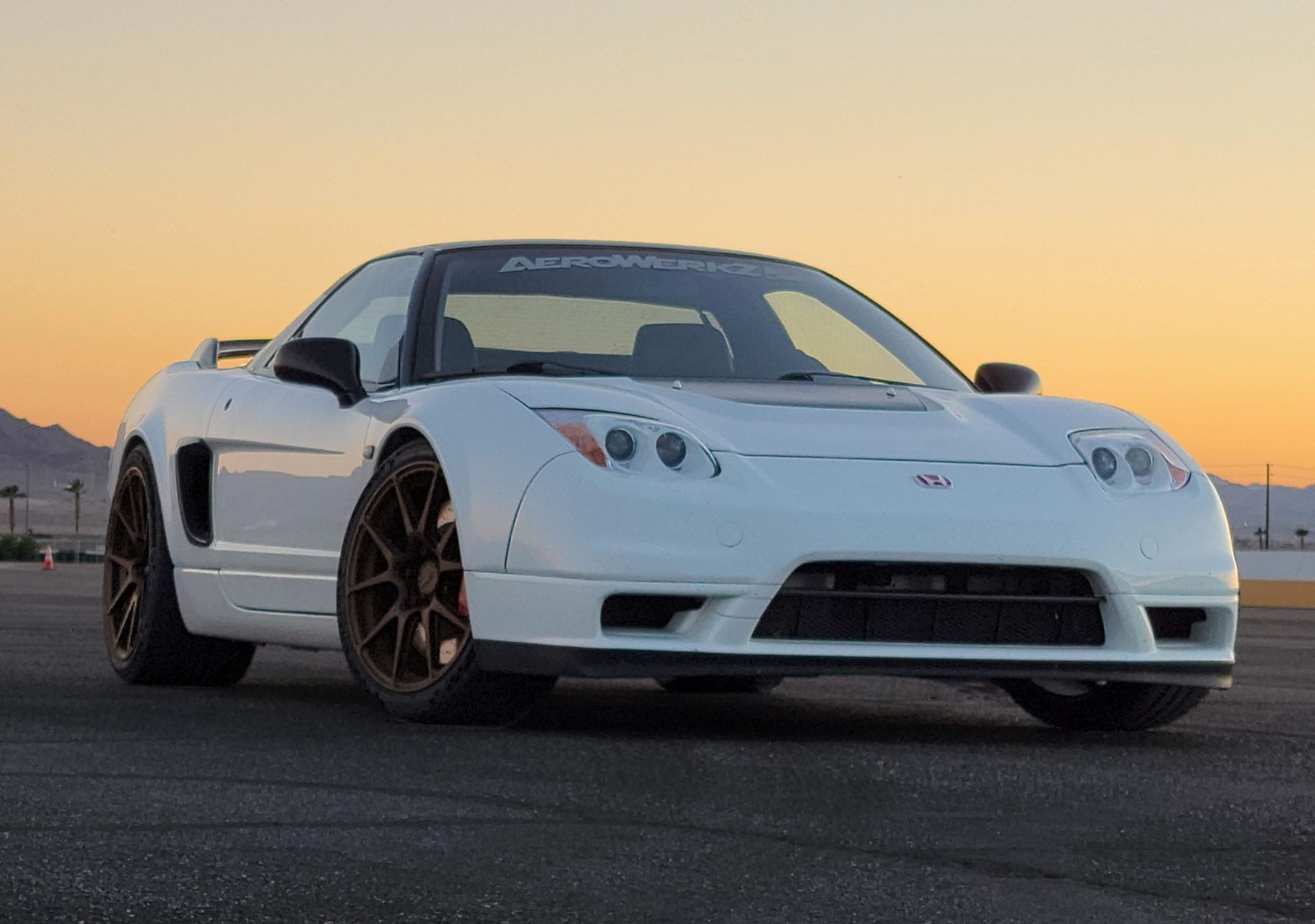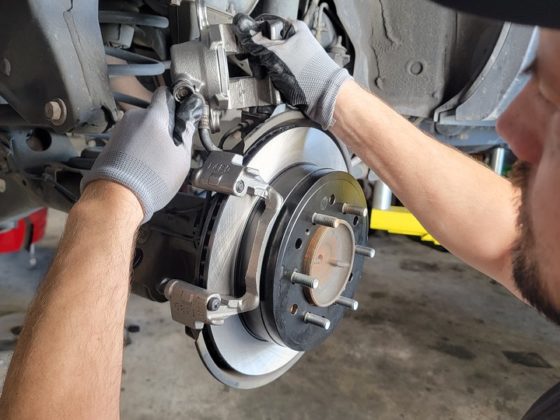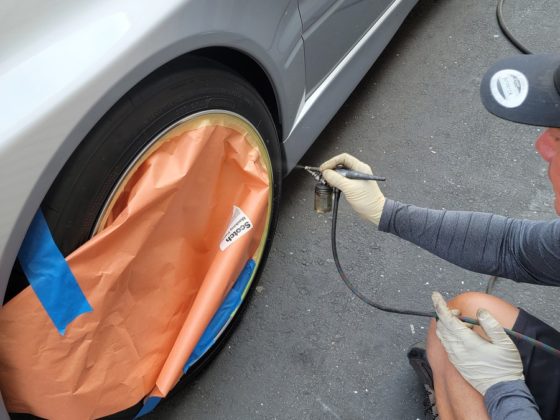 The front tire fits beautifully in the wheel arch. The black bronze contrasts nicely with the bright red PFC caliper and most of the huge 14” front rotors can be seen through the thin spokes of the Forgeline GA1R wheel.
The front tire fits beautifully in the wheel arch. The black bronze contrasts nicely with the bright red PFC caliper and most of the huge 14” front rotors can be seen through the thin spokes of the Forgeline GA1R wheel.
There is zero rubbing lock to lock on the fender or the chassis. The previous wheel setup rubbed on big bumps and at full lock, which definitely gets tiresome after a while.
 Out back, this 19” wheel also fills out the wheel arch perfectly. The 14” PFC brakes actually look on the smaller side, but these are some of the largest brakes ever put on an NSX, since most setups use 13” rotors.
Out back, this 19” wheel also fills out the wheel arch perfectly. The 14” PFC brakes actually look on the smaller side, but these are some of the largest brakes ever put on an NSX, since most setups use 13” rotors.
 From the rear ¾ view, these tires really mean business. On the street, these Michelin Cup 2 Connect (240) tires ride incredibly well. The tires are silent and soak up pavement changes with a dull, well-damped “thud”. The ride quality and lack of NVH for a daily driven car is one of the biggest reasons (in addition to on-track grip and performance) that made me desire this tire so much for the NSX.
From the rear ¾ view, these tires really mean business. On the street, these Michelin Cup 2 Connect (240) tires ride incredibly well. The tires are silent and soak up pavement changes with a dull, well-damped “thud”. The ride quality and lack of NVH for a daily driven car is one of the biggest reasons (in addition to on-track grip and performance) that made me desire this tire so much for the NSX.
There’s a reason so many world-class modern sports cars and super cars use the Cup 2 tire, because it’s unparalleled in how well it performs on track, and how well it rides on the street, with tons of feedback and communication of what the car is doing. These are at the top of my all-time favorite performance tires.
 Through the canyons, you can really feel the massive 305-width rear tires planting the rear of the car. Lowered NSXs are known to rotate into oversteer a little too easily when trail-braking due to the rear camber-gain and front roll center location of the car’s suspension geometry. This is a little excessive for turning fast laps and for having confidence and margin of error on the street. This big rear tire greatly offsets this problem and gives the car a ton of rear security and grip.
Through the canyons, you can really feel the massive 305-width rear tires planting the rear of the car. Lowered NSXs are known to rotate into oversteer a little too easily when trail-braking due to the rear camber-gain and front roll center location of the car’s suspension geometry. This is a little excessive for turning fast laps and for having confidence and margin of error on the street. This big rear tire greatly offsets this problem and gives the car a ton of rear security and grip.
With less than 280whp on tap, it’s hard to break these tires loose. There’s no doubt that once the car is turbocharged, these big rear tires will pay dividends in terms of grip and ability to put power down.
 Typically, running larger diameter wheels hurt how responsive or nimble a car feels. These wide 18” front, 19” rear GA1R wheels and Cup 2 tires don’t make the car feel heavier, but actually makes the car feel more stable and “planted”.
Typically, running larger diameter wheels hurt how responsive or nimble a car feels. These wide 18” front, 19” rear GA1R wheels and Cup 2 tires don’t make the car feel heavier, but actually makes the car feel more stable and “planted”.
 I’m really looking forward to tracking this package to see if the increased rear grip, and the massive front tire can improve the lap times over a typical 17/18 wheel and tire package at stock power levels.
I’m really looking forward to tracking this package to see if the increased rear grip, and the massive front tire can improve the lap times over a typical 17/18 wheel and tire package at stock power levels.
Overall, my calculations paid off, and I was able to stuff these 11” wide tire and 11.5” Forgeline GA1R wheels under the slightly wider Downforce fenders with no rubbing. I can now enjoy the amazing ride quality and steering precision and feel of the Michelin Cup 2 Connect 240 tire. Stay tuned for the back-to-back track test of this new wheel/tire setup vs a typical 17/18 wheel and tire package.




9 comments
Jesus Christ, that is one great-looking car! That massive rubber and functional stance really bring out the purpose of the NSX.
Thank you very much. It took a lot of planning and testing but i’m extremely happy with how everything came together visually and performance wise. Stay tuned for when we track test and compare it to standard 17/18 tire sizes!
Billy, you are making the best content out there on car websites right now. Keep it up. I also enjoyed seeing you in Dahm’s RX7 series!
Thank you for the kind words. I’m trying to put out unique and interesting content. Spread the word! 🙂
There will be more Project FD RX7 Restomod coming up soon, so keep an eye out!
Thanks for including the wheel and tire weights. Pretty amazing that you could add that much tire and still lose some unsprung weight.
Now you just need a twin-turbo and sequential gearbox to make the ultimate NSX!
“Plus, it raised the ride height by over an inch, which is not good for looks, handling, or performance.”
Do you have any idea if dropping an inch (going the other way) would help handling?
My logic as to why it may work, preserves suspension geometry, reduces unsprung weight, opens up possibility for cheap, fun tyres.
Reasons why it may not work, ground clearance.
The 1 inch smaller diameter tire will drop the ride height 0.5″ without any other change, which is a win-win. The ability to lower it another 0.5″ from a fender clearance standpoint will have benefits and negatives (lower center of gravity, but less ideal suspension geometry). Depending on the rest of the setup this can be good or bad, but typically it will still be good. Ground clearance isn’t an issue on track.
Thank you so much.
I’m a casual driver and would like to get a set of spare rims for track tyres. I’d like to go to 16″ down from my stock 17″ and maintain the tire sidewall height.
All this time I didn’t realize you were the wheelman with the Mustang too. Hopefully other tire manufacturers start offering stuff like this, namely Toyo as I’m required to run their tires in my series. It would be awesome to datalog tire temps and pressures over the course of a race.